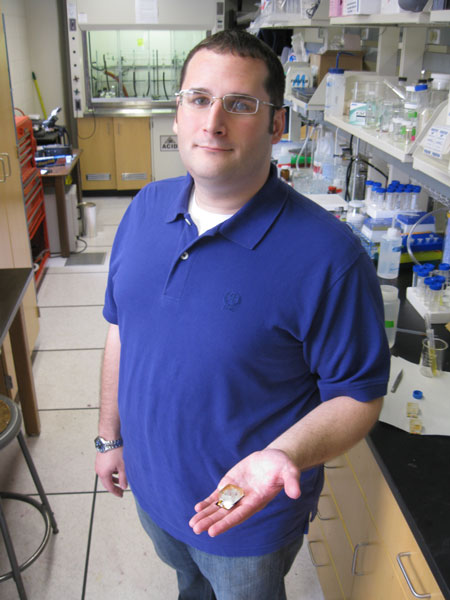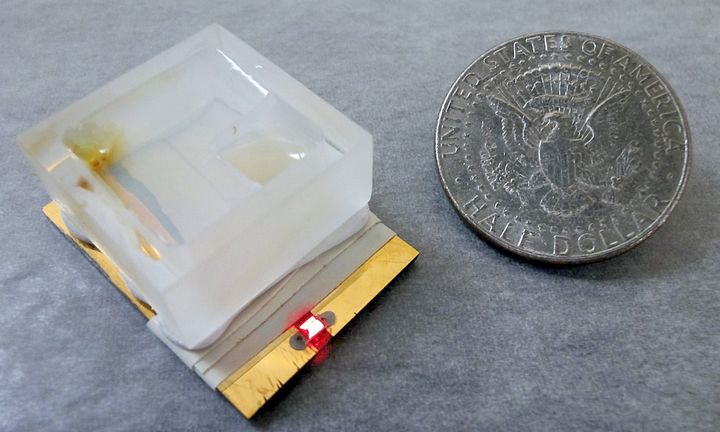Turning Reynold’s Wrap, JELL-O and milk into a way to look for organ failure.
 AUSTIN, Texas-A new low cost test for acute pancreatitis that gets results much faster than existing tests has been developed by scientists at The University of Texas at Austin.
AUSTIN, Texas-A new low cost test for acute pancreatitis that gets results much faster than existing tests has been developed by scientists at The University of Texas at Austin.
The sensor, which could be produced for as little as a dollar, is built with a 12-cent LED light, aluminum foil, gelatin, milk protein and a few other cheap, easily obtainable materials.
The sensor could help prevent damage from acute pancreatitis, which is a sudden inflammation of the pancreas that can lead to severe stomach pain, nausea, fever, shock and in some cases, death.
“We’ve turned Reynold’s Wrap, JELL-O and milk into a way to look for organ failure,” says Brian Zaccheo, a graduate student in the lab of Richard Crooks, professor of chemistry and biochemistry.
The sensor, which is about the size of a matchbox, relies on a simple two-step process to diagnose the disease.
In step one, a bit of blood extract is dropped onto a layer of gelatin and milk protein. If there are high levels of trypsin, an enzyme that is overabundant in the blood of patients with acute pancreatitis, the trypsin will break down the gelatin in much the same way it breaks down proteins in the stomach.
In step two, a drop of sodium hydroxide (lye) is added. If the trypsin levels were high enough to break down that first barrier, the sodium hydroxide can trickle down to the second barrier, a strip of Reynold’s wrap, and go to work dissolving it.
The foil corrodes, and with both barriers now permeable, a circuit is able to form between a magnesium anode and an iron salt at the cathode. Enough current is generated to light up a red LED. If the LED lights up within an hour, acute pancreatitis is diagnosed.
“In essence, the device is a battery having a trypsin-selective switch that closes the circuit between the anode and cathode,” write Zaccheo and Crooks in a paper recently published in Analytical Chemistry.
Zaccheo and Crooks, who have a provisional patent, can envision a number of potential uses for the sensor. It might help providers in the developing world who don’t have the resources to do the more complex tests for pancreatitis. It could be of use in situations where batteries are in short supply, such as after a natural disaster or in remote locations. And because of the speed of the sensor, it could be an excellent first-line measure even in well-stocked hospitals.

For Zaccheo, the most appealing aspect of the project isn’t so much the specific sensor. It is the idea we might be able to save time, money and even lives by adopting this kind of low-tech approach.
“I want to develop biosensors that are easy to use but give a high level of sensitivity,” he says. “All you need for this, for instance, is to know how to use a dropper and a timer.”
For more information, contact: Daniel Oppenheimer, College of Natural Sciences, 512 232 0682; Brian Zaccheo, Department of Chemistry and Biochemistry, 512-475-7461.

















Comments 5
Brilliant!! I wish they had had this when my Mom had her bout with AP. It took them so long to diagnose it. We live in a rural area and the hospital is small.
This is excellent, and as a Graduate Scientist I find this such a break-through. All the best with your future endeavors.
Hey!
Anything for chronic pancreatitis and how elevated amylase and lipase readings can be non-existent when having a severe attack? I have been to the E.R. a couple of times and they seem to think I am lying about my symptoms.
Al...
This is amazing. I live in the so called 'Arizona outback.' I honestly believe this can save countless lives. In remote areas like mine being cost effective is critical. Small hospitals who cannot afford to keep heat in the hallways at night, while always looking for inexpensive medical items could use this..
Cheers, love to see this type of approach to science!